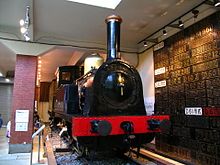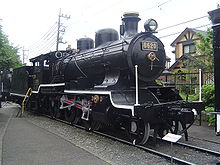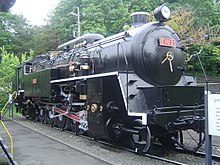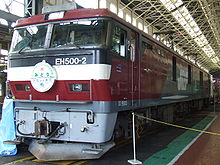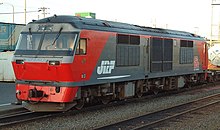Series scheme in Japan
The series scheme in Japan includes the numbering and classification schemes of locomotives and multiple units of the former and current railway companies in Japan .
Steam locomotives
Before nationalization
Before the nationalization of the Japanese railways in 1906/07, steam locomotives were numbered regardless of their type. Since the construction of the Kobe – Osaka railway in 1874, odd numbers have been used for locomotives in the Tokyo area and even numbers for locomotives in the Kobe region. However, this was not continued after the gap between the two railway lines was closed in 1889. Different locomotives such as the A8, B6 and rack railways were later redesigned to form groups for better differentiation.
Francis Henry Trevithick (1850-1931), a grandson of Richard Trevithick and employee of the Japanese government for the management of rolling stock, finally introduced series. He classified the locomotives with a Latin letter from A to Z. Another letter was added later (AB, AC, AD, etc.) This simple method has been revised once more over time. A letter and one or two digits described the type of locomotive. The letters had the following meaning:
- A - tank locomotive with two driven axles (A1 – A10)
- B - tank locomotive with three driven axles (B1 – B7)
- C - Tank locomotive for rack railways (C1 – C3)
- D - Tender locomotives with two driven axles (D1 – D12)
- E - Tender locomotives with three driven axles (E1-E7)
- F - Tender locomotives with four driven axles (F1 – F2)
Classification scheme from 1909
After the nationalization of the private railways , the railway authority introduced a new system of the series designation. The locomotives have now been divided into four-digit numbers. All older locomotives have been redrawn. The numbers 1 to 4999 were reserved for tank locomotives. 5000 to 9999 were intended for locomotives with tender. The series and serial numbers require a defined relationship to one another. The first digits denoted the series, the following digits were the serial number of the locomotive.
- 1–999 - Tank locomotive with two powered axles
- 1000–3999 - tank locomotive with three driven axles (from 3900 cogwheel locomotives)
- 4000–4999 - Tank locomotive with four powered axles
- 5000–6999 - Tender locomotives with two driven axles
- 7000–8999 - Tender locomotives with three driven axles
- 9000–9999 - Tender locomotives with four or more driven axles
The numbering within the series was usually serial. If the numbers were no longer sufficient, as was the case with the 8620 , 9600 and 9900 series , another number was added, so that a five-digit series designation was created. The 18900 series (later renamed the C51 series) was the only series that received a five-digit series designation right from the start. This numbering and classification survived the revision in 1928. Locomotives that were added to the inventory through the takeover of private railway companies by the state railroad, however, were redrawn according to the rules of 1928. The locomotives classified according to this scheme ran with this designation until the end of steam operation at JNR in the 1970s.
Classification scheme from 1928
When the series scheme of 1909 threatened to overflow, a new series scheme was introduced on October 1, 1928. With the exception of the 18900 , 8200 and 9900 series , which were renamed C51, C52 and D50, no existing series was redesignated. After this revision, steam locomotives were designated with letters and numbers.
- example
- D51 200
| D. | 51 | 200 |
|---|---|---|
| Number of driven axles | model series | serial number |
In contrast to electric or diesel locomotives , steam locomotives have no indication of their type of drive in the series designation.
- Number of driven axles
- A letter indicates the number of driven axles. Running axles or axles of tenders are neglected.
- 2 driven axles - B
- 3 driven axles - C
- 4 driven axles - D
- 5 driven axles - E
- model series
- In addition to the axis letter, a two-digit number indicates the series. A distinction is made between tank locomotives and locomotives with tenders.
- 10–49 - tank locomotive
- 50–99 - Tender locomotives
According to this scheme, the D51 200 is the locomotive with the number 200 of the D51 series. This series are locomotives with a tender with four driven axles.
Electric locomotives
Up to the series scheme of 1928
The Japanese State Railways imported their first electric locomotives in 1912. As with steam locomotives of that time, these were designated with four or five-digit numbers. The series was indicated from the first digit. The last digit was always a 0.
Below is a list of all electric locomotives that were named after this method:
| use | Flat track | Rack railway | ||||||||||||||
|---|---|---|---|---|---|---|---|---|---|---|---|---|---|---|---|---|
| model series | 1000 | 1010 | 1020 | 1030 | 1040 | 1060 | 1070 | 6000 | 6010 | 7000 | 8000 | 8010 | 10,000 | 10020 | 10040 | |
| Construction year | 1922 | 1923 | 1923 | 1924 | 1923 | 1926 | 1926 | 1925 | 1923 | 1926 | 1926 | 1923 | 1926 | 1911 | 1919 | 1926 |
| number | 2 | 2 | 2 | 2 | 17th | 4th | 3 | 3 | 6th | 6th | 2 | 8th | 2 | 12 | 14th | 2 |
| 1928 renamed to | ED10 | ED11 | ED12 | ED13 | ED50 | ED14 | ED15 | ED51 | ED52 | ED53 | ED54 | EF50 | EF51 | EC40 | ED40 | ED41 |
Classification scheme from 1928
In 1928 a new series scheme was introduced. Originally, electric locomotives were classified according to their top speed. Higher-speed locomotives were used in passenger transport and slower locomotives were used in freight transport. This scheme was later adapted in order to classify the series according to their power system - ( direct current , alternating current or multiple system ).
- example
- EF81 95
| E. | F. | 81 | 95 |
|---|---|---|---|
| Electric | Number of driven axles | model series | serial number |
- E.
- All series of electric locomotives begin with an E .
- Number of driven axles
- The following letter indicates the number of driven axles. Running axes are neglected.
- 2 driven axles - B
- 3 driven axles - C
- 4 driven axles - D
- 6 driven axles - F
- 8 driven axles - H
- model series
- Together with the letter "E" and the axle letter, the following two digits identified the series. Originally a distinction was made between three groups:
- 10–39 - Locomotives with a top speed of 85 km / h or less
- 40–49 - rack-and-pinion locomotives
- 50–99 - locomotives with a maximum speed of more than 85 km / h
- After the revision, the classification was as follows as of 1987:
- 10–29 - DC locomotives with a top speed of 85 km / h or less
- 30–39 - AC / DC locomotives with a top speed of 85 km / h or less
- 40-49 - AC locomotives with a top speed of 85 km / h or less
- 50–69 - DC locomotives with a top speed of more than 85 km / h
- 70–79 - AC locomotives with a top speed of more than 85 km / h
- 80–89 - AC / DC locomotives with a top speed of more than 85 km / h
- 90–99 - prototypes
- serial number
- The serial numbers always start with 1. However, individual blocks were also skipped to create sub- series , such as the EF65 1000 series or the ED75 700 series .
According to this series scheme, EF81 95 designates the 95th locomotive of the EF81 series . This series is a multi-system series with six driven axles and a top speed of over 85 km / h.
JR Freight
Of the seven Japan Railways Group (JR Group) companies founded in 1987, only the Japan Freight Railway Company (JR Freight) has put new electric locomotives into service. Originally, JR Freight had the JNR locomotive series continue to be built with slight modifications. In 1990, the first new locomotive series of JR Freight was introduced with the EF200 . This was named according to the JNR scheme with two letters and three digits. The JR East also adopted this rule when it introduced its first new class EF510 locomotive in 2010. This locomotive is a variant of the JR Freight locomotive of the same name.
- example
- EH500-10
| E. | H | 500 | - | 10 |
|---|---|---|---|---|
| Electric | Number of driven axles | model series | serial number |
The meaning of the Latin letters corresponds to that of the class scheme from 1928. A hyphen separates the class number and the serial number of the locomotive.
- model series
- The three-digit numbers are used to indicate the series. The classification according to the maximum speed has been replaced by a classification according to the power system and drive motor .
- 100–199 - DC locomotives with DC motors
- 200–299 - DC locomotives with AC motors
- 300–399 - other direct current locomotives
- 400–499 - AC / DC locomotives with DC motors
- 500–599 - AC / DC locomotives with AC motors
- 600–699 - other AC / DC locomotives
- 700–799 - AC locomotives with DC motors
- 800–899 - AC locomotives with AC motors
- 900–999 - other AC locomotives
According to this scheme, the EH500-10 is the tenth locomotive in the EH500 series . This is an AC / DC locomotive with eight driven axles and AC motors.
Diesel locomotives
JNR
The history of diesel locomotives at Japanese Government Railways began with two series made in Germany, the diesel-electric DC11 from 1929 and the diesel-mechanical DC10 from 1930. The Ministry of Railways named them according to a scheme similar to that used for steam and electric locomotives at the time. The JNR adopted this rule.
- example
- DD13 1
| D. | D. | 13 | 1 |
|---|---|---|---|
| Diesel locomotive | Number of driven axles | model series | serial number |
- D.
- All series of diesel locomotives begin with the letter "D".
- Number of driven axles
- A letter indicates the number of driven axles. Running axes are not taken into account.
- 3 axes - C
- 4 axes - D
- 5 axes - E
- 6 axes - F
- model series
- Together with the letter D and the following letter that describes the number of driven axles, the following two digits designate the series. The digits are assigned according to the maximum speed.
- 10–39 - Locomotives with a top speed of 85 km / h or less
- 40–49 - prototypes
- 50–89 - locomotives with a top speed of more than 85 km / h
- 90–99 - prototypes
- serial number
- As with electric locomotives.
According to this scheme, DD13 1 means the first locomotive of the DD13 series. This is a diesel series with four driven axles and a top speed of 85 km / h or less.
JR Freight
After the privatization of JNR in 1987, two "Japan Railways" companies put new diesel locomotive series into service. The East Japan Railway Company (JR East) put the DD19 series into service. This was a variant of the JNR series DD17 and was accordingly designated with two digits according to the JNR scheme. The second company was the Japan Freight Railway Company (JR Freight) to commission completely redesigned locomotives. These were named according to the new three-digit scheme.
- example
- DF200-12
| D. | F. | 200 | - | 12 |
|---|---|---|---|---|
| Diesel locomotive | Number of driven axles | model series | serial number |
The meaning of the Latin letters corresponds to that of the JNR scheme. A hyphen separates the series from the serial number.
- model series
- The first three digits are used to designate the series. The classification according to the maximum speed was replaced by a classification according to the type of power transmission and the type of engine used in diesel-electric locomotives.
- 100–199 - diesel-electric locomotives with direct current motors
- 200–299 - diesel-electric locomotives with AC motors
- 300–399 - other diesel-electric locomotives
- 500–799 - diesel-hydraulic locomotives
According to this series scheme , the DF200-12 is the twelfth locomotive in the DF200 series . This series is a diesel-electric locomotive with six driven axles and AC motors.
Shinkansen auxiliary locomotives
All locomotives used on the Shinkansen network, e.g. B. for maintenance and shunting activities are diesel locomotives. The series is designated with a three-digit number. The serial number of the locomotive follows after a hyphen. The two classes 911 and 912 are currently in use.
In the Shinkansen series designation, the first 9 stands for wagons and locomotives that are not used for passenger transport. The second digit 1 stands for diesel locomotives.
Hybrid locomotives
JR Freight
In 2010, JR Freight put its first diesel-battery hybrid locomotive HD300-901 into service. The meaning of the HD300 class is as follows:
- H - hybrid locomotive
- D - four driven axles:
- 300 - The main motor is a synchronous motor
Shinkansen
The Shinkansen series of the "JR Group" companies, with the exception of JR East, are named chronologically after their commissioning with a series number increased by 100. The first series was subsequently given the number 0. The only exception here is the N700 that emerged from the 700 series with a prefixed N.
These series include classes 0 , 100 , 200 , 300 , 400 , 500 , 700 , N700 and 800 .
JR East has been using its own scheme since 1994. Your Shinkansen series are also counted chronologically. However, an E is prefixed here and the series are increased by one in accordance with the order in which they are put into service. These classes are the E1 , E2 , E3 , E4 , E5 , E6 and E7 .
International distribution
The scheme is also used by PT Kereta Api Indonesia .
See also
Individual evidence
- ↑ Seki, Takahiro: Denkikikansha - Color Books No. 533 . Hoikusha, Osaka 1981, pp. 102 (Japanese).
- ↑ "JR 東 日本 と し て 初 の 新型 電 気 機関 車 の 導入 に つ い て" (First order of modern electric locomotives by JR East), JR East news release, December 2, 2008 (PDF; 76 kB). Retrieved December 3, 2008.
- ↑ "新型 入 換 専 用 機関 車 (試 作) の 形式 名 と デ ザ イ ン に つ い て" (Series name and design of new switcher Lokomotive prototype), JR Freight news release, February 10, 2010 ( Memento of the original from February 15, 2010 on the Internet Archive ) Info: The archive link was inserted automatically and has not yet been checked. Please check the original and archive link according to the instructions and then remove this notice. (PDF; 85 kB) accessed on February 10, 2010.
